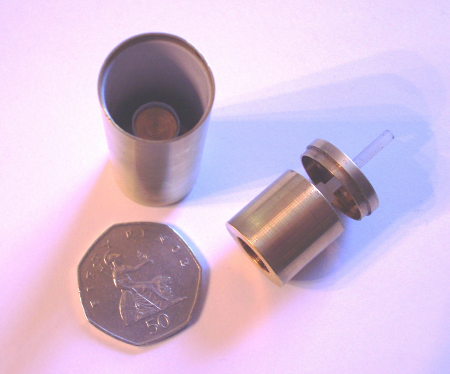
A New Class
A novel class of tuneable microwave cavity sensor has been developed within the Department of Physics at the University of Oxford UK and patented with a view to further product development with industrial partners. Microwave cavity resonators offer excellent sensitivity and have a range of potential applications in fluid monitoring through detection of change in dielectric properties of samples entering them. This type of sensor offers the ability to conduct both static and dynamic in-line monitoring.
The newly created sensor comprises a resonant microwave cavity weakly coupled to an amplifier with large gain that feeds into a Robinson-style limiter. The limiter is in turn weakly coupled back to the resonant cavity to form a closed-loop oscillator architecture. The device is a sensor by virtue of the frequency measurement and demodulator outputs that are connected into the microwave feedback loop just prior to the limiter.

Fig. 1: The newly developed tuneable microwave cavity sensor consists of a resonant microwave cavity weakly coupled to an amplifier with a large gain feeding into a Robinson-style limiter.
Unique Features
A notable feature of the design is the very large system loop-gain at low amplitude and the provision of a Robinson limiter with custom-engineered non-linearity to hard-limit this loop-gain at working amplitude. This combination has the advantages of totally defining the operating characteristics of the oscillator and delivering an excellent amplitude noise performance.
The high small-signal loop-gain allows the coupling between the resonant cavity and the electronics to be made very weak, resulting in a high Q factor. This provides high detection sensitivity and further contributes to the low noise floor. In turn, the combination of these factors leads to a high signal-to-noise ratio and low thermal drift when employed in sensor applications. The weak cavity coupling additionally offers excellent amplitude and frequency stability and low thermal drift.
Building A Composite Sensor
Viewed as building blocks for development of a composite sensor, or a sensor system, devices incorporating these features offer reliable operation even in high loss circumstances due to the large gain at low amplitude. High accuracy and reliable calibration can be achieved owing to the low drift and to the operation of the limiter.
Furthermore, good reproducibility between different units occurs as the weakly-coupled cavity makes the design highly independent of the characteristics of the individual semiconductor devices. Finally, sensors produced using this technology can be used to give two independent signal outputs that may be used to measure different parameters or used in parallel to permit greater precision.
We can summarize this new sensor by saying the Robinson is the pinnacle of radio-frequency oscillator design and represents real engineering. The nonlinearity is constructed by the designer and implemented in a way that makes the oscillator performance independent of voltage, temperature, and the individual devices used so that the product is both highly accurate and reproducible.
Also, since the Robinson is a multistage system with significant gain reserve, the resonant circuit is highly decoupled from the semiconductors so that the frequency is extremely stable and can reliably be used for measurement. Unlike other types of oscillator, a Robinson device delivers "belt-and-braces" operation that simultaneously produces two independent measurement outputs that may be correlated with one another to deliver improved precision and reliability.
Initial Conclusions
The large gain reserve and highly-controlled nonlinearity mean that a Robinson-driven cavity can be relied upon to oscillate every time, irrespective of voltage, temperature, or electrical loading induced by proximity to an electrically lossy target. This sensor design has the potential to improve detection in a range of industries that include:
- Aviation: detection of icing of aircraft, reducing the use of fuel consuming heating systems.
- Automotive: detecting weak magnetic and non-magnetic contamination. This could include applications such as the detection of moisture build-up in engine oil or brake fluid or wear-and-tear detection.
- Chemical Engineering: in-process monitoring of chemical reactions through the study of changes in dielectric constant of reaction components.
- Medicine: detection of magnetic nanoparticles within the field of in vitro diagnostics.
About the Author
Professor John Gregg obtained a D Phil in Physics for work on the fundamental magnetism of Van Vleck systems under the guidance of B. Bleaney and F. N. H. Robinson. He made the first observation of Enhanced Nuclear Acoustic Resonance and is considered an expert in the field of Spintronics. He holds 19 patents and is the Academic Founder of an Oxford University spinout company. Prof Gregg is working with Isis Innovation - the technology transfer company of the University of Oxford - to identify commercial partners to further develop his technology. Parties interested in finding out more should visit http://isis-innovation.com/licence-details/fluid-monitoring-applications.
Related Stories
Mini Gyroscope Set To Put A New Spin Navigational Apps
Scientists Make Temperature Sensor From Tobacco Cells
Computational Imaging Opens Door For Innovative Lens Design